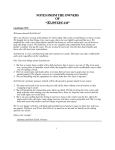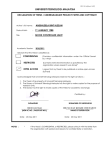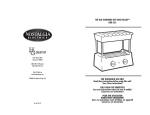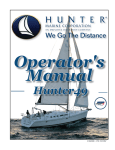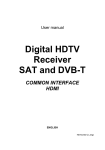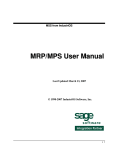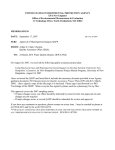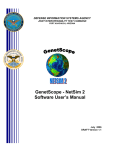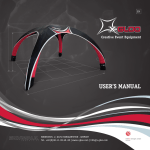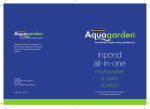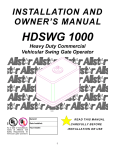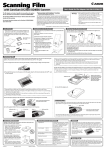Download “ISLAND ESCAPE” Hunter 356
Transcript
OWNERS’ NOTES Revised/Edited 4/10/2011 “ISLAND ESCAPE” Hunter 356 WELCOME ABOARD! From Giles and Shannon Little INTRODUCTION We would like to welcome you and your family and friends to share our Hunter 356 sailboat on the waters of the US Pacific Northwest! We have done everything we can to make this boat beautiful, comfortable, and easy to sail. We hope you have a wonderful time. Please treat her like she is your own boat. Please take a few minutes and scan these notes which are intended to help you deal with some of the equipment and sailing gear on board. That way, you can easily answer a few of those “How do I operate the ----“questions, and help us keep “ISLAND ESCAPE” in great shape for all to enjoy. ISLAND ESCAPE is a smoke free boat. We respectfully ask that you do not smoke inside or on the boat. Please only light up when ashore! We thank you for your consideration. The following pages document some of the essential characteristics of the boat. Familiarity with this information will make your sailing experience aboard significantly easier and enjoyable! Please sign our guest book and tell us a bit about your adventure aboard. Also let us know how we can clarify or add to these “Owner’s Notes” to improve the information. We will also consider all suggestions included with your post-charter report to the San Juan Sailing staff, including needed maintenance and repairs as safety and fun are our priorities! Bon voyage. Giles and Shannon Little, Owners Revised/Updated April 10, 2011 Table of Contents. Subject SAFETY ABOARD Our 5 favorite things about Most prominant quirks Anchors and Anchoring Anchor windlass Barbecue Battery system/Charging Berths Bilge Pumps Boarding Ladder Boat Specifications CD player Dinghy Dodger/Bimini Electrical power Electronics section Island escape. E - Electrical Panel The Battery (12 Volt) Circuit Breakers/Switches Emergency Starting AC (120Volt) Shore Power AC (120V) Temporary Power DC (12V) Battery Power Anchor Windlass Chargers & Cellular phones House Lights Auto-pilot Furuno Color Chart Plotter & Radar Depth Sounder Knot Meter VHF Radio Wind Indicator - Starting Shifting gears Engine Operation Overheating Shut-down Emergency/Safety Engine Fuel Tank Hatch Board storage Head & Holding Tank - Flushing - Emptying the holding tank Heater/Diesel Inverter Micro-wave A B C D ‐ 2 ‐ G H I J K L M N O P Q R S T U V W X Y Z AA BB CC DD EE FF GG HH II JJ KK LL MM NN OO PP QQ RR Outboard motor Refrigerator & Freezer Sails and Rigging Shower Spare Parts and Tools. Stove - propane Trash, Dustpan, Handbroom, Vacuum TV and DVD player Water - Hot and Cold GUEST NOTES -Starting and Operation Sails and Handling characteristics Main sail Deploy, Furl, reef. Jib Deploy, furl - Stove operation - Appliances - Water pressure Tankage Fresh Water Tank Holding Tank & COMMENTS ‐ 3 ‐ SS TT UU VV WW XX YY ZZ AAA BBB CCC DDD EEE FFF GGG A: SAFETY ABOARD Safety is the primary concern of all, Captain and Crew alike. PLEASE take time to review all safety features of “ISLAND ESCAPE” before you set off on your cruise. This includes location of the Life Sling and related equipment, use of the GPS to set a “Man Overboard” waypoint, location of fire extinguishers, safety harness, etc. The Captain /Skipper is responsible for his/her crew knowing the safety features and following instructions in an emergency. LIFE JACKETS are stored in the Wet Locker located in the Shower/Head compartment. All crew should try on and properly fit a jacket prior to departing from any anchorage or dock and should know at all times where “their” jacket is located. Life Jackets are mandatory whenever in the Dinghy. Use of the radar/chart plotter (GPS), VHF radio, depth sounder, and other instrumentation as well as official government charts should be considered as assists to promote safety and safe navigation BUT not as a substitute for continuous alertness and caution. B: FIVE FAVORITE THINGS ABOUT “ISLAND ESCAPE” 1. In-Mast Mainsail. Wow, what a great feature to have for cruising the inland waterways! Breezes come and go. Reducing sails or furling at the end of a long tack back to the docks can be handled from the cockpit and that’s it! No sail ties, no folding, just getting on with the fun. Remember though, that it is the outhaul and not the halyard that you need to release when furling!(speaking from experience). You never need to touch the halyard. 2. Power Windlass. Pulling chain and anchors is NO FUN. Let “Oscar” do it all for you! Stow the chain and lash the anchor in the bow bracket and then relax. It’s done! Launching the anchor is also a snap – Just count the markings and set the anchor at the proper depth. 3. Storage. There are lots of storage areas inside and out. Keep it neatly organized and you can find anything quickly. Check the inventory for items kept on board. There are storage areas under almost every cushion and mattress in the boat! 4. The new comfortable memory foam mattresses make it hard to get out of bed in the morning! 5. Extended Battery Capacity and Combiner/Start-Battery Isolator. Play Pinochle until midnight! The Start Battery is isolated and kept at full charge. The four deep cycle battery house system provides an ample service at 400 amp hours. Battery charging is automatic, and no battery switching is required. ‐ 4 ‐ C: MOST PROMINENT QUIRKS IN OPERATING “ISLAND ESCAPE” 1. In-Mast Mainsail Furling line. The Blue control line for the in-mast mainsail furling has a thickening at the splice causing it to sometimes ‘jam’ at the cleat on the cabin-top. It often takes an extra tug to pull the splice through the cleat. This line also ‘locks’ at the winch mounted on the mast. A small lever on the topside of the winch will release the line and let it pull or slack without engaging the winch. Try it both ways and see which works best for you. Revised 4/10/2011 2. Power Windlass: Use of the power windlass is great – but jamming the anchor chain is a royal pain and can be a hazard under stress or in an emergency. The chain MUST be kept clear of the leading edge of the windlass and not allowed to pile up and block the anchor feed or kink as the chain peels off the gypsy cogs. If releasing the clutch (port side of windlass) does not solve a jam, it may be necessary to unbolt the top cover to clear the gears and release the jam. By then, the circuit breaker will have blown, and will need to cool and be reset. Observing caution is the best bet! 3. Checking the Oil. Yes, there really IS an oil dip-stick! It is located almost at the floorboard level on the port side (facing motor from inside the cabin) below a bunch of hoses. A modest “flag” is normally attached to the pull ring. A black mark has been drawn on the fiberglass outside the engine cover to indicate where (fore & aft) the elusive dip-stick is located. IF the flagging should be missing, please add something clever or bright-colored to help the next sailor. 4. Lighting the Stove. While the stove should light automatically - once the tank is opened, the Solenoid is opened and the breaker is opened - it often doesn’t respond. Just think Propane BBQ Starter, open the appropriate burner valve on the stove, and forget about ‘automatic’. Just pretend you are really having a BBQ each and every time you use the stove-top. 5. Color Chart Plotter. It’s simple to use, really. HOWEVER, once in a blue moon, the plot acts up and wants to play hide and seek. That is, the entire plot will not show, being partially blank (yellow). Switching (zoom in or out) to another setting (scale) will almost always reset the plot and allow you to return to your original scale. Failing that, just turn the unit off for a minute or so and turn back on. Get back on course and watch for the rocks! AND, remember that the GPS plotter is ONLY a tool to assist in navigation! Relevant CHARTS are kept aboard and should always be your first source of information courses and hazards. 6. The holding tank ALWAYS reads full. This is because it is not hooked up to the main panel. There is a light just below the main panel that will go on when the holding tank is full. Revised 4/10/2011 7. The bilge pump is always activated. This will go on when water enters the bilge for whatever reason. The “sump” is responsible for emptying the water when you are showering. Please make sure the sump is turned on when showering. If it is not, water will spill into the bilge, and the bilge pump will have to pump it out. Revised 4/10/2011 ‐ 5 ‐ THINGS YOU SHOULD KNOW ABOUT ‘ISLAND ESCAPE’ D: ANCHORS AND ANCHORING ISLAND ESCAPE is equipped with two anchors, one forward in the anchor locker and one in the port swim locker. The primary bow anchor is a plow-type with 200 feet of chain and 220 feet of rope. The line is marked in red at 20-foot intervals. The secondary/stern anchor is a Danforth with 60 feet of chain and 200 feet of nylon line. Island Escape draws 6”5” therefore it is advisable to allow a minimum of 10’ clearance. The stern tie line is a coil of 200 feet of yellow line in the aft port swim step locker for stern tying in case of close anchoring. The anchor scope used in the San Juan and Gulf Islands is generally 2-4 to one. As most anchorages are 15’ to 40’, expect to let out about 60’ to 100’ of chain/anchor line. Have the helmsman shift to reverse idle for at least 30 seconds to set the anchor. Half-speed reverse for about one minute will assure the anchor is secure and reduce the possibility of dragging the anchor under adverse winds or current. E: Anchor Windlass The electric anchor windlass first REQUIRES power from a switch on the navigation station control panel. An additional hinge-type circuit breaker for the windlass circuit is located under the chart table. Last, the up-down foot controllers for the windlass are on the forward starboard deck just aft of the anchor locker. If the anchor chain jams and/or the windless is used to pull the boat up to the anchor (instead of using the engine in low-forward gear) it is likely that the Circuit Breaker will open and power to the deck switches will be lost. Start the engine prior to operating the Windlass to avoid tripping the breaker and potentially drawing down the starting battery. Release the anchor by untying the small line retaining the chain, and pushing down with your foot the switch with the arrow pointing forward. Watch the chain and anchor line markers to determine the amount of scope released. Release the anchor sufficiently upwind so that the actual position of the boat (and swing circle) is clear of other anchored boats, rocks, or other obstructions. Check the low tide depth anticipated during your time at anchor and assure sufficient depth is available over the duration. CHECK the tide tables and correction for the locale from the sources stowed in the book rack behind the chart table. Retrieving the anchor requires good planning and crew coordination. When retrieving the anchor, never use the windlass to pull the boat up to where the anchor is set. Instead, head the boat under power toward the anchor while using the windlass to take up the stack chain. Using the “up” button with the arrow pointing back, retrieve the chain and anchor line slowly, and finally secure the anchor. Once the anchor is out of the water, retrieve it by hand, placing the anchor’s shaft on the rollers, and then lifting it into place. Stow the remaining chain with slow, short activation of the windlass, leaving a small amount of slack in the chain. Throughout the retrieval process, KEEP THE CHAIN CLEAR OF THE ‐ 6 ‐ FORWARD SIDE OF THE WINDLASS TO AVOID JAMMING the gypsy and potentially throwing the circuit breaker. IF power is lost, clear the chain (using the clutch on the right side of the gypsy, or if that fails to release the jam, carefully remove the cover plate by removing the two screws) and check the circuit breaker and reset as necessary by closing the small black lever on the breaker by raising it to a horizontal position. Have the helmsman maintain position over the anchor set position by using idle-neutral with head to wind. KEEP the engine running throughout the retrieval process in order to avoid accidental tripping of the circuit breaker as the windlass requires significant power. Engine power will also be needed to maintain position and reduce strain on the windlass motor and gearing. Secure the anchor with the tie thru the anchor chain and close the foot switches. Turn off the breaker switch on the main electrical panel. Revised/Updated 4/l0/2011 F: BARBECUE The stainless steel propane BBQ is mounted on the starboard side on the stern rail. It operates on propane by use of the ‘pigtail’ hose connected to a separate tank in the propane locker. The tank valve must first be opened... Upon completion of use, the tank valve should be closed. When active use is finished, make sure the regulator knob is OFF. As a courtesy to the next guest, please use the wire brush attached by wire to the barbecue to clean the grill. Also, replace the kettle cover to keep the BBQ out of the elements. IF the “automatic” spark igniter fails to operate properly, the BBQ may be started by simply using the ‘propane match’ lighter provided by SJS. Revised/Updated 4/10/2011 G: BATTERY SYSTEM/CHARGING ISLAND ESCAPE is equipped with a four deep cycle battery system. The master battery switch is located on the bulkhead beneath the chart table. You may simply leave the switch in the ON position The isolator assures all batteries are charged, while protecting the engine start battery from draw-down by house usage. The two battery banks are located in the cockpit locker compartment under protective covers. The 4 deep cycle batteries are connected in series to provide 400 ampere-hours for house 12 volt power requirements. The Isolator detects remaining charge and will automatically keep the start battery bank at full charge and reserved for engine starting. . In an emergency the battery switch can be set to “Combine” to temporarily boost starting power. Also See “Electrical Power/Panel” section of these notes. H:BERTHS Island Escape is ideal for four adults. She can sleep seven . Two can sleep in the forward cabin with 6’ headroom and a birth 75” long, narrowing from 82” to 12” at the bow. The aft cabin has 6’4” headroom and a queen size inner-spring mattress sleeps two. The main salon table when made into a birth is 36” forward, 52” aft and 80” long. (This requires lowering the salon table and using the settee cushion insert.) The port settee measures 22” forward, 30” aft and 79” long. To date this is the only place I have slept and it is actually very comfortable. ‐ 7 ‐ Lowering the Salon Table The salon table can be lowered to make into an additional bunk: Remove all the table seat cushions Pull the pins on both sides of the table mount Lower the table until it rests on the wooden supports Replace the seat cushions The filler cushion is stored in the forward V Berth when not in use. I:BILGE PUMPS. There are two bilge pumps. The electric bilge pump is controlled at the electrical panel. However, the pump also has an automatic float switch wired directly to the battery bank. When there is enough bilge water to “float” the switch, the pump engages even if it is turned off at the electrical panel. Turn on the sump pump manually when showering. The sump pump empties water from the shower and refrigerator without letting the water enter the bilge (the white box under the stairs is the sump pump and hoses). Beware: If you shower without the sump pump on, water will spill into the bilge and can lead to an unpleasant odor until the bilge is cleaned and pumped. An emergency portable bilge pump is located in the cockpit storage locker in a clear bag. There is also a manual bilge pump handle in this locker that can be connected to fitting in the cockpit should you lose power and/or need to rapidly remove water from the boat. Hopefully you will never hear the shower sump pump start automatically. If you do, please investigate immediately and report it to San Juan Sailing either by phone or VHF (channel 80) if there is a significant problem, or upon your return if a minor problem. J: BOARDING LADDER A small white boarding step is provided at the San Juan Sailing dock for Island Escape. This step folds and may be taken aboard for use at other ports of call. There is also a larger blue set of steps located in the port lazarette which are more secure and make it easier to get on board when at dock. ‐ 8 ‐ K:BOAT SPECIFICATIONS All boat specifications such as LOA, LWL, draft, tank capacities, serial numbers, etc., can be found in the front of the guest book. L: CD PLAYER/STEREO The Sony CD player operates like a car stereo Simply experiment with the regular buttons to gain familiarity (see instruction guide in the front of this notebook for added detail). To load a CD, the “open” button is located in the right upper corner. The Front panel will swing down for you to put the CD into the black felt slot (red light underneath it). To play the CD, close the panel and it should play automatically. To change tracks, press the ‘seek’ button on the right of the panel. To take the CD out, reopen the panel and press the red eject button to the left. Close the panel. The stereo will beep three times when the unit is turned off on the main control panel. This is normal. Use the “FADE” function to activate the speakers in the cockpit, to have both inside and outside speakers operating, or to return audio to the cabin only. This unit also has a jack for aux. players such as mp3 players. M: DINGHY ISLAND ESCAPE has a hard bottom inflatable 10’2” Avon RIB dinghy. For tie-up after anchoring or for towing, you should tie on the starboard side to avoid the furnace outlet vent. Towing works best when the dinghy is brought close to the boat—about 4 or 5 feet off the stern. This lifts the bow, reduces drag, and lessens the chance of wrapping the painter around the propeller. Tie the painter off twice—once at a portside cleat then tie the bitter end to the stern rail. Keep track of the oars as well. The oars should be stored flat inside the dinghy when under tow. Island Escape has a Honda 2-HP 4-stroke outboard motor. See the section in these notes for “Outboard Motor” for additional information and operating instructions. The outboard motor holds about 1/3rd gallon of regular gas (no oil mixing is needed!) Do not store spare gasoline on the boat except inside the outboard engine. An extra gas container may be secured inside the dinghy. The inflating pump is stored in the small bow locker, together with a pump-out hose and limited repair kit. (See section “Outboard) for motor operating instructions.) PLEASE check regularly that the TWO dinghy drain plugs on the transom are SECURLY in place prior to towing or heading out to the crab-pot or for ice cream ashore! Please use special care when beaching the dinghy (refer to the dinghy beaching procedure in your charter guest book). Most of the beaches in the Islands are strewn with barnacle covered, bottom slicing rocks. When approaching the shore, weight the dinghy aft by leaning or moving toward the back of the dinghy. Revised/Updated 4/23/2010 Then offload everyone over the bow. Lift the dinghy/outboard motor using the hand lines on either side above the barnacle “line”, and deposit the dinghy gently on the beach. Also remember to secure the painter under a rock or to a log - especially in the case of a rising tide. Carefully lift the dinghy off the beach and launch carefully beyond the shore rocks rather than dragging it when departing the beach. ‐ 9 ‐ N: DODGER/BIMINI The dodger windows are plastic “glass” that is vulnerable to scratching from salt crystals, especially after sailing into a challenging breeze. The salt spray on the glass dries in the wind, leaving behind tiny salt deposits that obscure your vision. Please avoid directly touching the glass with a rag or sponge. It’s like rubbing the glass with sand paper! To clean, use generous amounts of fresh water from a hose, a pan from the galley, or a sopping wet sponge to “flood” the glass and dissolve the salt crystals away. Please do not toss items (winch handles, fenders, life jackets, etc) on top of the house and potentially hitting the dodger windows. If the dodger glass is really clear, you can thank previous guests for their diligence. And we thank you too! Dodger Adjustment for Sun//Rain The Dodger consists of three separate sections. The center section may be either removed or installed in order to accommodate the wishes of the Captain and Crew relative to both sun and rain. To remove the canvas center section, first unzip the forward edge using the zipper pulls from each outboard edge. Once the zipper is open, the canvas is removed by slowly pulling the hard aft edge from the slot, pulling either to port or starboard. Carefully roll the unit taking care to NOT crease the Plexiglas window, and store the unit securely below out of the way. This provides a nice selection of both sun and shade in the cockpit. To reinstall the center canvas for either full shade or protection from rain, slide the hard track aft edge into the slot on the Cockpit Bridge, then close the zipper from each side. Close the snaps and enjoy! A canvas companionway hatch cover is also provided to offer privacy and/or ventilation when the hatch boards are not in use. If removed, please roll and store safely to prevent bending the vinyl window. O: ELECTRICAL POWER Electrical Panel The Electrical System is the “Brains” for meeting all the electrical power requirements for ISLAND ESCAPE. There are two electrical subsystems on board. The Battery System (see Battery/Charging) is 12 volts, and supports most lighting and instrumentation functions. In addition, an isolated battery is the electrical source for starting the diesel engine. The Shore Power System operates on 120 Volt AC Power, obtained by connecting the Shore Power cord to an appropriate 30 Amp shore connection, available at almost all Marinas. (Adapters are provided for 20 Amp or 50 Amp connections.) In addition to powering the Battery Charger, several components onboard require AC power. See sections following. Both power systems have circuit breakers/resets which need to be checked should either system fail to function. Revised/Updated 7/21/2010 P: The Battery (12 Volt) A reset is located on the bulkhead below the chart table. The Shore Power (AC breaker) is located on the aft bulkhead inside the port cockpit locker. Q: Circuit Breakers/Switches Breaker switches for activating component sub-systems and equipment for the two ‘systems’ are arranged separately on the master electronics panel located in the salon above the chart table. The Battery functions are located on the left, with the Shore Power functions on the right. Each ‐ 10 ‐ section has a master system switch located at the top of the respective section Most switches at the panel board are self explanatory, but some circuits are unique. R: Emergency Starting In emergency starting situations only, the battery switch may be set temporarily to “COMBINE” to boost available amperage. Should the ignition fail, there is a bypass starter button located under the companionway steps (behind/under the engine cover) near the engine hour meter. S: AC (120Volt) Shore Power ISLAND ESCAPE is equipped with a 50’ yellow shore power cord for this use. (Stored in the cockpit locker ) To connect the AC Shore Power, first make sure the AC Master Switch is turned off. Also assure the shore power source is also turned off. Connect the shore power cable to the three-pronged plug on the outside of the port stern rail, carefully engaging the black retaining ring. Then connect to the shore power source. Turn on the shore connection, then the AC Master switch on the Electrical Panel. Reverse this process when disconnecting the AC Shore Power. Activate the A/C main when you are connected to shore power and use the individual breakers (electrical panel switches) to power various appliances. The various switches are selfexplanatory, and can be individually turned on or off as desired. An Amp meter located next to the Panel will help you monitor the power consumption from the 12-Volt system as various components are used. The AC outlets only function while the boat is connected to shore power. If the AC plugs are not “on,” check the GFCI’s in the receptacle just past the chart table. If power is lost, check the AC circuit breaker located on the aft bulkhead in the large cockpit storage locker. Reset the breakers as necessary, which should then power up the AC side of the Electrical Panel. T: AC (120V) Temporary Power ISLAND ESCAPE also has a portable 300 watt inverter that can be used on a short term, limited basis to provide AC (120 V) power when a shore connection is not feasible. The primary application for using the inverter is to power up the TV/DVD player when at anchor and thus AC shore power is unavailable. Both the TV and DVD units operate on AC (120 V) power only. Hence the inverter is necessary in order to operate these units from the house battery system (12 V) whenever shore power (AC) is not available. A double 12 volt plug is provided for this purpose. Please leave the TV attached to the cabinet wall. The inverter and DVD unit are stored in the forward berth on the port side, where the inverter is plugged into the 12V system. You can also use the inverter for powering other small appliances, such as laptops, game boys, phone chargers and CPAP units that do not draw much amperage. Electric hairdryers, razors, recharging units, and things that require high amperage will not work. Revised/Updated 4/10/2011 The Battery Charger also operates on AC (120V). TURN OFF the AC Battery Charger switch on the electrical panel before starting the Engine in order to prevent damage to the charger or batteries. ‐ 11 ‐ U: DC (12V) Battery Power Please acquaint yourselves with all the DC switches and what each switch operates or controls. The Main DC switch controls all the functions on the left side of the electrical panel. The DC Circuit Breaker RESET is located on the bulkhead below the chart table. V: Anchor Windlass The switch is located on the electrical panel but there is also a circuit breaker on the bulkhead below the chart table. See anchor section for details regarding use of the windlass. IF the chain jams and/or the windlass is used to pull the boat up to the anchor (instead of using the engine in low-forward gear) it is likely that the Circuit Breaker will open and power to the deck switches will be lost. W: Chargers & Cellular Telephones ISLAND ESCAPE is equipped with 6 12-volt “cigarette lighter” outlets that may be used for recharging your cellular telephone. To activate the plug on the port side of the steering pedestal in the cockpit, turn on the “Charger” breaker switch on the DC side of the main electrical panel. Cellular/wireless phone reception in the Islands can be quite variable by individual carrier. Be aware that Roaming Charges can be quite expensive, especially when wireless calls are routed through Canadian cellular services. This frequently happens when in the vicinity of both Stewart Island and Sucia Island even when in US waters. X: House Lights The interior lights on ISLAND ESCAPE are all controlled by a single breaker on the DC Electrical Panel. BUT there are both individual light switches and group switches, depending on which set of lights are to be used. Just outside the Head, close to the LP Gas switch, there is a single White light switch that controls most (but not all) of the recessed ceiling lights as a single circuit. Separately, there are small pole switches on the ceiling light at the base of the companionway steps and those in the forward berth compartment. The wall-mounted swivel lights are also controlled by small switches on the lamp base. Adjust the lighting to your needs. Y: ELECTRONICS The depth sounder, wind instrument, and autopilot are all Raytheon products. There are laminated Raytheon-prepared quick operating reference guides in the white SJS Charter notebook (or, in the chart table) to assist in using the various instruments. . If you take them out during your charter, please return them to the notebook for the next charter guests. Detailed User Guides are included in the literature packets stored in the storage compartments below the Chart Table. The power for the navigation instruments is activated by turning on the Autopilot Switch on the DC control panel. A handheld Garmin GPS can also be found in the chart table. Push in the red button to start it. Push in and hold the red button for 3 seconds to turn it off. Revised/Updated 7/21/2010 ‐ 12 ‐ Autopilot Island Escape is equipped with an autopilot unit that can be used to steer the boat on a pre-set course while the Skipper is preoccupied with other short-term tasks or for extended open passages where obstructions, other boats, or shallow water are NOT likely. IT IS IMPERATIVE that full attention be given to sailing conditions and the location and course of the boat at all times. The autopilot is only an aid for sailing/cruising and is not a substitute for a primary focus on conditions and safety. The unit is NOT designed to independently steer the boat into heavy weather or strong seas. This may cause the control mechanism to disengage and/or the drive belt to slip. The Autopilot is activated by using the Autopilot breaker switch on the DC Panel. This is the same switch used to activate the other electronic instruments as well. There are TWO controls that are used in combination. When steering a desired course, the black clutch lever located on the starboard side of the wheel is pushed downward into a locked position. Then, the toggle buttons on the instrument head are used to engage/disengage the unit (“Standby” disengages the unit’s compass control mechanism) while pressing again will engage the unit. IN ADDITION, the clutch lever MUST also be disengaged when switching to “Standby” by bringing it up to a horizontal unlocked position. Leaving the clutch lever engaged will quickly damage the motor/drive unit due to manual steering of the boat using the wheel against the tight friction of the drive unit. Whenever going to “Standby” with the compass control also disengage the clutch! A temporary small stretch cord may be used to hold the clutch engaged if necessary. Z: Furuno Color Chart Plotter and Radar This instrument is installed at the helm. The radar switch at the electrical panel powers up this unit and the other instruments. Then use the Power Brill button on the display unit at the helm to turn the plotter on/off. A “long press” will turn the unit off and on. A “momentary press” opens the display for adjustment of brilliance, etc. Rotate the “Enter” knob to make adjustments, and then press to enter your selection of menu options or adjustments. An abbreviated “User Guide” is located in the book rack and will answer most routine operating instructions. The instrument’s full User Manual is also in the book rack. The plotter is fairly simple to use, and is much like a standard GPS with map plotter. You won’t hurt it by experimenting with the various functions a bit to learn basic operations. Please leave all basic setup functions as pre-set so that other users can easily operate the system. AA: Depth Sounder The digital depth sounder will not give accurate readings beyond 200’. It is designed for use in shallow waters. In deeper water, the sensitivity on the unit increases as the transducer tries to get some reading back. Consequently, you will receive many false readings caused by currents, changes in water temperature, fish, and seaweed. Use the depth sounder only as an aid to navigation in shallow water. However, the key to avoiding rocks is not the depth sounder—but knowing where you are at all times. Rocks are the greatest navigational and safety hazard in the islands—but they are all clearly marked on the official government charts. San Juan Sailing has also clearly marked danger areas in RED on the charts. We do not recommend using the alarm. It is likely to sound at inappropriate times such as late at night while fish are passing beneath the transducer. While underway USE BOTH the charts provided aboard AND the chart plotter. ‐ 13 ‐ Also, remember that most driftwood (including large logs) FLOAT and MOVE and must be spotted visually in order to avoid serious damage to the driveshaft and prop. Revised/Updated 4/23/2010 BB:Knot Meter If the digital knot meter shows a reading of “0.00” while underway, the impeller is most likely clogged with a piece of eelgrass. Sometimes it will float off overnight. You can also try removing it by powering in reverse for a short distance. However, the GPS input to the chart plotter also provides an alternative and quite accurate indication of speed over the ground. The knot meter indicates movement relative to the water, and is impacted by tidal current, etc. CC: VHF Radio You should monitor channel 16 (the hailing and distress channel) during your cruise (It’s the LAW). For non-emergency communications, after establishing contact on channel 16, switch to working channels 68, 69, or 79. Scan the weather channels for the one with the best reception before sailing in the morning and prior to anchoring for the evening. Remember to use proper procedures when using the VHF and, in most cases, use the low power option to reduce onchannel congestion and interference. This is generally a light wind region but weather changes can be sudden. Listen for the “inland waters of western Washington”. You will hear “Strait of Juan de Fuca” (lies south of the San Juan Islands), “Georgia Strait” (lies north), and “Rosario Strait” (runs through the eastern part of the San Juan Islands). The remote access microphone (RAM), when plugged into the port side of the pedestal, controls all radio functions of the unit mounted above the navigation station from the steering station. This can be very convenient while entering and leaving moorings. To operate the Remote VHF, first carefully plug the unit into the pedestal connector, and then turn on the panel breaker AND the main VHF radio switch. Then activate the ON switch for the remote. In case of a distress where you can no longer stand by the radio to pass your mayday, use the red distress button on the radio. First flip up the cover, then press the button. San Juan Sailing monitors channel 80 during office hours (closed Sundays). By phone you can also reach the San Juan Sailing office at (800) 677-7245 or San Juan Sailing owner, Roger Van Dyken, at (360) 224- 4300 (cell) or (360) 354-5770 (home). Emergency contact numbers are also included in the white SJS Charter notebook. DD: Wind Indicator The wind indicator is mounted at the masthead. The instrument indicates both apparent and true wind angle and wind speed in knots. The instrument is set to report apparent wind as the default. IF you change this to true wind, please return the setting to apparent wind before leaving the boat at the end of your time aboard. A small black square appears on the screen below the “True” or “Apparent” labels, designating which setting is currently active. A small placard in included (normally in the Chart Table) giving further details. ‐ 14 ‐ EE: EMERGENCY/SAFETY In addition to the notes on Safety at the beginning of these notes you will find the following items on board: Fire Extinguishers –3 - cockpit locker, companionway, and forward stateroom. Life Sling and gear – located on the stern railing and stern lazarette Revised/Updated 4/23/2010 Revised/Updated 7/21/2010 Flare Kit –cockpit locker Fog Horn - (manual) and extra canisters – cockpit locker Radar Reflector – Shelf in cockpit locker Emergency tiller – cockpit locker Emergency rudder post – cockpit locker Flashlights – 2 – chart table and companion way First Aid Kit – under sink in head. Spotlight –a high powered Led/Halogen handheld rechargeable Spotlight is located in the hanging locker in the aft cabin. It is AC/DC rechargeable as well as “hand crank.” Absorbent Pads (Diesel spill while fueling, etc) – forward shelf, cockpit locker FF:ENGINE ISLAND ESCAPE is powered by a 27 HP Yanmar Diesel engine. This is a very reliable engine and is the MOST IMPORTANT MECHANICAL SYSTEM aboard. Understanding how to use the engine is absolutely essential for having an enjoyable and stress-free charter experience. Please make an extra effort to fully understand the engine system before leaving the San Juan Charter docks. Ask questions, and practice all operations and functions BEFORE departing from the docks. GG: Starting the Engine ALWAYS check that the thru-hull valve for the engine cooling water intake is OPEN before starting the engine! THEN: Check the oil level. Island Escape consumes very little oil during cruising and rarely needs oil added. Access to the engine is by unlatching the companionway stairs and pulling them towards you. The dipstick is accessed by tilting the stairs forward and locating the dipstick (with colored flagging) on the lower starboard side of the engine. There is a wide gap on the dipstick between the full line and the fill line. IF oil is needed, do not overfill. Use the onboard spare oil to add no more than a cup at a time. Then check the level again. Overfilling can be harmful to a diesel engine. The excess oil will escape somehow, perhaps by blowing the head gasket. Also, if the dipstick seemingly indicates no oil the first time you check it, reinsert and try again - the correct level will show when the air lock bubble is broken. Expect the oil to be blacker than that of a gasoline powered automobile engine. This is normal for a diesel after only a few hours of operation. While the cover is removed, check the coolant levels. Check for belt tightness, leaking fluids, and a clear raw water strainer (under the floorboard hatch at the base of the companionway stairs where the thru hull fittings are located). Secure the companionway engine cover. Look over the stern for things that could foul the propeller. ‐ 15 ‐ Make sure the gearshift (black handle at the pedestal) is in neutral (straight up) with the black clutch pin pushed in. Push the throttle lever about 1/3 forward. Do NOT put the transmission into forward gear! Insert the key and turn it clockwise. There is not a glow-plug on this engine. The warning buzzer will sound because there is no oil pressure. Press and hold the starter button. Expect the engine to start in 5 seconds or less. If the engine doesn’t start after 10 seconds of cranking, turn the key to the left and remove it. Wait 15 seconds and try again. An emergency start button is located in the engine compartment UNDER THE STEPS if the regular starter fails. Revised/Updated 4/23/2010 After the engine starts, release the start button, check for water gurgling out the exhaust, then gradually ease the throttle back to a slow idle. While the engine warms, check your fuel level. To activate the gauge, go the Chart Table DC control panel and turn on the tank minder switch. Directly above, you will see the Tankminder panel. Turn it on and use the up/down key to move thru the indicators for the levels for fuel, fresh water, and holding tank. Please allow 5 minutes of warm up before placing a load on the engine. Except in an emergency!. It is very hard on a diesel to be placed under load when cold. HH: Shifting Transmission Gears When you bring the throttle back to the straight up position, the clutch pin will pop out. Now you may engage forward gear by pushing ahead on the throttle or reverse gear by pulling back on the throttle. Please remember to pause in the straight up (neutral) position when shifting from forward to reverse and visa versa. This engine tends to shudder if shifting goes rapidly from forward to reverse. Shift slowly, going thru neutral for a few seconds. New transmissions are expensive! II: Engine Operation The 27 HP Yanmar 3 GM series engines are very reliable. Cruising speed is approx. 6 knots at 2800 RPM. Refuel when the fuel drops below ¼ full in order to avoid the possibility of sucking air or sludge into the engine when the fuel level approaches 1/8 full. Based on using 75% of the 37gallon fuel capacity yields an approximate 300-350 NM range. Please do not exceed 3000 RPM. It is hard on the diesel to push past the designed hull speed and will yield very little increase in speed. Running at higher engine RPM will significantly increase fuel consumption. At 2800 RPM, the engine uses about 0.50 to 0.79gal/hr. in relatively smooth water (depending on currents and wind). JJ: Engine Overheat The engine should normally run at about 160-170 degrees (F). Check the gage frequently. If the buzzer sounds after the engine is running, immediately check the exhaust discharge on the transom. The alarm buzzer is more likely to indicate engine overheating. IF water is NOT exiting the discharge port, there is a strong likelihood that the cooling water intake filter is blocked or that the water pump is malfunctioning. Turn off the engine. Check the coolant level after the engine cools down. If there is no water discharged, the seawater strainer is likely plugged with eelgrass. The best solution is to prevent ‐ 16 ‐ this problem from occurring —keep alert for eelgrass masses, especially along those “soapy” tide and eddy lines in the water. IF eelgrass gets sucked into the engine cooling water intake, it jams the raw water strainer. To clear the strainer first raise the floorboard just forward of the companionway stairs for access. Before clearing the strainer, close the seacock below the strainer, and then remove the top of the strainer by turning it counterclockwise. Extract the stainless steel filter element. Remove the eelgrass. Open the seacock momentarily to assure that it is not clogged. Close the seacock again and carefully reinsert the stainless steel filter element into the strainer. Replace the lid and tighten by turning it clockwise until the lid is seated on the rubber gasket. Be sure to REOPEN THE SEACOCK! If the engine overheats again upon restarting, check that you remembered to reopen the seacock. If it is open, check the seal between the strainer and its lid. If the strainer is drawing air, it won’t draw water. (If needed, shut the engine down, close the seacock and open and retighten the lid on the strainer.) If water IS exiting the discharge port, the engine has most likely lost oil pressure. Check the oil pressure gauge frequently. Immediately shut down the engine, check the oil level, and if pressure is not restored contact the Maintenance Professional and/or San Juan Sailing. See emergency contact numbers in the white SJS Charter notebook. Revised/Updated 4/23/2010 Revised/Updated 7/21/2010 KK: Engine Shutdown. Do NOT turn off or remove the ignition key while the engine is running! First bring the engine to idle and the gearshift to neutral. Allow the engine 5 minutes to cool down. Then pull the fuel cut-off handle at deck level, down by your left foot. After the engine stops, turn off the ignition and remove the key. LL: FUEL TANK Diesel refill fitting is located starboard, stern deck, aft of the railing. A universal key to open the fitting is in the chart table. Please be very careful when fueling. The 37-gallon tank is located under the aft berth. Never allow maximum flow from the filler hose. If you do, the fill tube will surge and diesel will spill from the vents onto the side and onto the deck. It takes only a few drops of diesel fuel in the water to create sheen and subject you to a Coast Guard fine. Fill slowly and carefully. When the pipe begins to gurgle like it is full, you are probably full. You may also be able to see the diesel when looking down into the fill tube. Check the side vent and, with soap, wipe up any excess fuel to avoid yellowing the stern and polluting the water. Also be very careful of drips when removing the hose. Diesel and shoe bottoms are a very slippery and dangerous combination. After wiping, please use soapy water to scrub down any drips so it does not stain the fiberglass . MM: HATCH BOARD STORAGE. The two piece wooden hatch boards can be safely and securely stored in the canvas pockets mounted on the inside bulkhead of the large cockpit locker. This pocket unit is made to fit as well as to protect the Plexiglas and Teak boards. Please use this pocket accessory to keep the boards protected and out of the way. ‐ 17 ‐ NN: HEAD AND HOLDING TANK. Please do not put anything in the toilet that hasn’t been eaten. Deposit toilet paper (and feminine items) in the waste basket next to the toilet, not down the toilet. Zip loc bags also work well. ISLAND ESCAPE has a 30-gallon holding tank mounted in the rear swim step locker of the boat on the starboard side. San Juan Sailing staff will discuss holding tanks and pump-outs at the predeparture Skipper’s Orientation held upon your arrival Flushing A Holding Tank Full red indicator light is located on the navigation station bulkhead below the electronics panel and has been calibrated to empty and full. The Red light will light when the tank is nearly full. The separate Tank Indicator that gives levels for Fuel and Water is NOT accurate and should not be used for the holding tank. (Also see information under heading “Water – Hot and Cold Pressure System/Holding Tank” in these notes). Flushing may be done by pump-out at several stations located throughout the cruising area, although facilities are somewhat limited and frequently out of service. Island Escape has a macerator pump and discharge thru-hull valve as explained below. This should be used only in broad, open waters where there is good water circulation and NOT activated in port or at anchorages! Tank treatment solution is located in the cabinet under the sink in the (head). There is no “Y” valve. See the basic pumping procedure printed on the pump handle unit, and the small instruction chart posted in the Head. First, move the lever to the “Wet” (Left) position and pump 2-3 full strokes to wet the bowl. Use the head, and then move the lever to the “Dry (Right) position and pump until the bowl is completely clear. Reopen the intake (“Wet”) and pump several times to fully clear the discharge line to the holding tank. This may take 6-7 or more full strokes. Finally move the lever to the closed (Dry) position, and pump to fully clear the bowl. IF there is any backflow, the discharge line needs to be cleared (“Dry”) to avoid both odor and spillage! Revised/Updated 4/23/2010 OO: Emptying the Holding Tank: The holding tank may be emptied by either use of shore-based pump-out stations or by use of the macerator pump and thru-hull valve. The tank may be pumped when convenient and it is preferable to empty the tank regularly instead of simply waiting until the ‘full’ indicator light appears. Avoid pumping when located in a small bay or anchorage. Pump-out may be accomplished when underway. A separate deck pump-out connection is provided for use when using shore-based pump-out stations. Follow the instructions posted at the station facilities. Procedures for use of the macerator pump-out are given below: 1. The master thru-hull valve is located inside the port-side swim step locker. For safety and to avoid the need to access the swim step while the boat is underway in open waters, the holding tank discharge line is plumbed with an air loop so that once opened the valve may be left open while the vessel is in active use. The holding tank will retain all materials in the tank until the macerator pump is activated. The thru-hull valve handle should be pointing in the same direction as the hose when open: yellow handle up. When closed: the yellow handle will be pointing side-ways. ‐ 18 ‐ 2. When the discharge valve has been opened (see above) first turn on the primary macerator switch located on the 12-volt control panel. 3. Push and hold the secondary macerator button just under this switch until no waste can be seen exiting the stern of the boat. This may take three to four minutes. When the effluent is frothy and bubbly, the tank is empty. Slowing the engine to forward/idle and having a crew member listen for a change in pitch of the macerator motor from inside the aft cabin is a good way to know when the tank is empty and to avoid burning out the motor. It is desirable to also rinse the tank by liberally flushing (+/- 100 ‘pumps’) water through the toilet and repeat the discharge process to reduce clogging and odors. Release the secondary macerator button to stop pump operation. Then, turn off the main macerator switch on the panel. 4. THAT’S IT! There is no immediate need to close the thru-hull valve. Add new tank treatment solution through the toilet to assist in solids breakdown and to reduce odors. This is stored under the head sink. If the toilet flushing pump starts to resist your flushing efforts, DO NOT continue or force the handle down. Exploding or leaking sewage is most unpleasant! Search out the problem and correct it. If you pump out the holding tank at a shore facility, please fill it with fresh water through the deck fitting to rinse, and then pump it out again. The pump-out deck fitting is located aft, just under the barbecue on the starboard side. Don’t confuse this with the Diesel Fuel fitting! PP: HEATER/DIESEL The Webasto diesel cabin heater is located in the outboard portion of the port swim locker. Because the unit becomes very hot, a longitudinal panel separates it from the cabin wall. The heater is a forced-air system, so check to see if the outlets are opened or closed in the forward berth, salon, and/or aft berth as desired. Adjust to personal preferences. Revised/Updated 7/21/2010 The heater control is located above the Chart Table, to the right of the Stereo and above the AC Electrical Panel. The “Off-Heat” switch turns the heater on and off. The Up-Down arrows are used to set the desired salon temperature. After setting the temperature, the digital dial will revert to showing the current temperature and the heater will activate as necessary to reach/hold the desired temperature. The fan will continue to run while the unit is cooling down. There are outlets at floor level in each cabin and in the main salon. The heat is dry, comfortable, and on those rainy days or cool evenings, makes a huge difference in cruising comfort! Please be patient! It may take several minutes for the heater to ignite once it is turned on and the thermostat set. You will likely hear the fan operating during the startup phase. There is ALSO an electric back-up heater located under the lazarette cushion nearest the TV which can be used in lieu of the diesel heater while connected to AC 120 V shore power QQ: INVERTER – See AC Temporary Power and Electrical Power RR: MICROWAVE Use only when plugged into shore power!! SS: OUTBOARD MOTOR – See separate notes related to using the dinghy. The Outboard User Manual is included in the Charter Notebook. The standard outboard engine is 4 cycle – No oil mixing is required. Use Regular Unleaded Fuel only. ‐ 19 ‐ Start Procedure and Operation Make sure Emergency clip/lanyard is attached to engine stop switch (Red button, lower right side.) Open Fuel Cap Vent Knob – 3-4 turns – counter clockwise. Move the Fuel Value Lever to the “on” position (Lower left side) Set throttle lever to “start” position (Grip Handle) If Engine is “cold”, pull choke knob out. If engine is warm or has been running, chocking is not necessary. After engine s tarts, run for 1-2 minutes, push choke in. Pull the Recoil Starter Cord slowly until taut – then pull briskly. Engine starts. Use throttle friction knob to set throttle tension to your preference. To Reverse Engine, turn throttle to “slow” (neutral) and then turn outboard 180degrees and pivot throttle Handle Set throttle to lowest setting (slow) for neutral When stopping, simply push/hold red “stop” button. Close duel Cap Vent Know and Fuel Valve Lever in order to prevent fuel leakage. TILT engine up and lock position with small latch lever on bottom, left side. TT: REFRIGERATOR & /FREEZER The well-insulated DC powered refrigerator/freezer must be turned on at the electrical panel. The thermostat is in the fridge compartment. The approximate dimensions of the refrigerator are 16”x 13”x 24” deep with two shelves. The freezer works best (coldest) when things are placed close to the internal freezer element. Items placed there will remain frozen, or will freeze items such as containers for ice. Freezer dimensions are 14” x 13”x 21” deep with one shelf. We recommend running the refrigerator during the day only, turning it off and keeping the cover tight at night. This will help conserve the house battery power unless you are plugged in to shore power and have the battery charger turned on. Water from the refrigerator/freezer drains into the sink drain. Revised/Updated 4/23/2010 UU: SAILS and RIGGING. Sailing & Handling Characteristics. ISLAND ESCAPE is a delight to sail. Her sail plan features a 130% roller-furling jib and an inmast furling main, without spinnaker. This sail plan was selected with consideration for single or short -handed sailing as well as relaxed cruising. Under power, she backs hard to port. However, once she has sternway, she is easily steered with small rudder changes. Her perfect breeze is 15-20 knots with heel at 15-20 degrees. Full sail can be carried in winds up to 18-20 knots. It is easy to use the roller furling to incrementally shorten your sails. If you shorten the jib, you may want to move the jib cars forward to get a better sail shape and more control. CAUTION: Be sure to close and lock the forward hatch when preparing to raise sails as the jib sheet can be caught in it when tacking and the hatch could be damaged or pulled off. ‐ 20 ‐ Both sails have roller furling. This makes it possible for one person to easily handle all the sails. Brief instructions are as follows: VV: Main Sail Island Escape is equipped with the Selden “Furlin’ main sail furling and reefing system, with InMast Mainsail. A few minutes to acquaint yourself with this system for mainsail reefing and furling will be well worth the effort once you leave the dock and are underway. The key components of this system are: In-Mast Furling Reefing Winch (located below the Boom on the aft side of the mast Clew Outhaul “Endless” Furling Line (double blue line) led to cockpit (Port side of Companionway) Clam-cleats for locking “Endless Line” To Deploy the Main Sail (Unfurling): Point the boat directly into the wind. (The sail can also be deployed on course, if fewer than 15 knots of wind.) Open both clam cleats on the line stoppers holding the “Endless Line” - the solid blue lines on the port housetop. It is the circular line that turns the Reefing Winch on the mast. The Reefing Winch has a control lever which can be set to “lock” (ratchet) the line or alternatively to ‘free’ which releases the winch to allow the line to move freely. This line is continuous and the splice where the line is joined is bulky and may stick or jam at the clam cleat on the cabin house. Simply pull the line through the cleat opening by hand in order to free the line while deploying the main sail. Pull the Clew Outhaul line at the Clam Cleat on the starboard housetop until the sail is all the way out and then snub it down. Using the primary winch is advised as the sail nears full set position. It is not necessary to ‘work’ the blue reef line when deploying the Main Sail. You do NOT need to winch the sail all the way out. It is much easier to manually pull the sail out and then use the winch to trim it! Adjust the sail angle with the main sheet adjustment or traveler (located on the overhead dodger support stainless bar). Revised/Updated 4/10/2011 To Furl the Main Sail: Head the boat to a close reach course in order to get a nice tight wrap on the in-mast furling. Close the “Endless Loop (blue line) clam cleat closest to the companionway hatch. See point 2 above regarding the bulky splice in the blue line potentially jamming at the clam cleat. Put a wrap around the primary winch with the Clew Outhaul to keep it taut. Open the outer blue line Clam Cleat. Begin pulling the “Endless Loop” blue line at the inner Clam Cleat. This will pull the sail back into the mast. To Reef the Main Sail: The Mainsail may be reefed at any intermediate position by first setting the Reefing Winch to “FREE” and then carefully slacken off the outhaul line. Continue easing off the Clew Outhaul to roll in the desired amount of sail. The leach should be kept fairly taught. Keep slight tension on the outhaul to do this. Use the Primary Winch to take up the slack on the Endless Loop. When ‐ 21 ‐ the desired amount of sail is rolled in, use the clew outhaul to stretch the foot of the sail. Make both ‘sides’ of the “Endless” reefing line fast to prevent slip on the Reefing Winch. If reefing from the mast, activate the lock (Ratchet”) on the Reefing Winch before reefing the sail. Use a winch handle, but NEVER leave the handle in the Winch! As noted, he mainsail Reefing Winch has a lever with two settings on it: “ratchet” and “free”. In higher wind situations this lever will need to be set to “ratchet” to help hold the mainsail in a reefed position and reduce stress on the Primary Winch. . You will find a slight difference in operation between the “free” position and the “ratchet” position. In the “free” position the continuous furling line will work in both directions to furl the mainsail. In the “ratchet” position the “Endless” furling line will only furl in one direction. When leaving the boat, always lock the Reefing Winch to help reduce sail flutter. WW: Jib Sail To Deploy the Jib Sail: Point the boat directly into the wind. In mild winds, the Jib may also be deployed (and furled) while on a normal course. The crew should adjust the jib sheet to keep the clew under control while setting the sail. Release the jib roller furling line (starboard yellow line) Pull on the jib sheets. and sail your proper course! To Furl the Jib Sail: Point the boat directly into the wind, or in mild conditions maintain a steady course. Pull the jib roller furling line Keep gentle pressure on the jib sheet so the headsail will furl tightly Tie off the roller furling line. XX: SHOWER Hot water is stored in the insulated 6 gallon tank located under the aft bed. It takes about 30 minutes of running the engine under load to get hot water. When on shore power, you can switch on the AC (120 V) switch on the electrical panel to heat your water electrically (also in about 30 minutes). Experienced cruisers adhere to the sailor’s shower: “get wet, turn it off, soap up, rinse off”. Be sure to turn the sump pump on at the DC electric panel. CAUTION: the engine can heat the water to scalding temperatures! On warm, sunny days, an alternative to the below deck shower is the swim platform shower. This is also a good way to rinse off salt after swimming or dirt after going ashore. Revised/Updated 4/23/2010 YY: SPARE PARTS AND TOOLS: ISLAND ESCAPE carries a modest supply of spare parts and working tools. An orange-red Spare parts box and round clear plastic container are stored in the wet locker located in the Head compartment. A few items are also stored in the primary Yellow Toolbox. An inventory listing of spares is provided in this notebook and a copy is included in the orange box. The large Yellow Toolbox is located in the aft portion of the storage compartment below the port side settee. A companion black Secondary Toolbox with socket and crescent wrenches, etc (a narrow Black ‐ 22 ‐ box) is located in this same compartment. A Multi- Tester (electronic) is stored in the Chart Table. ZZ: STOVE-PROPANE The gimbaled propane stove has two burners and an oven. Two propane tanks are located in the aft cockpit starboard locker. Propane is heavier than air and requires caution. For your safety, please carefully follow these procedures: Make sure all stove control knobs are in the “off” position! THEN: Open the main valve at the propane tank all the way open and very slightly snug. Turn the LPG switch on the DC control panel ON. Next activate the electric solenoid switch located on the navigation station wall. A red light will appear, and you’ll hear a click in the propane locker as the solenoid valve opens. Ideally, no match is necessary. Push and hold in the stove control knob for a few seconds and turn to the left to high. The burner should light immediately. However, it is often difficult to light the stove automatically, so having a propane starter available is prudent and is often necessary. The oven should also light automatically by pushing knob in, turning it until it clicks – then continue pressure on the knob and turn it to the desired temperature. Hold the knob a bit longer, then release. When finished with the stove, shut off the burner(s), and then shut off the solenoid switch. (What little propane remains in the line from the tank to the galley is insignificant, and even if this tiny amount of propane were to leak into the cabin, it would not cause a problem.) If you do not intend to use the stove again in the next several hours, it is recommended that the main valve on the propane tank also be shut off. Both the solenoid valve and the hand valve protect against a potential propane leak into the main cabin. Please note that both propane valves – the hand valve and the solenoid valve – are located in the propane locker in the aft of the cockpit, which is isolated from the rest of the boat and is vented directly overboard. Any leaks within this compartment will vent down, out, and away from the boat. While the propane tanks normally last for two weeks or more, the San Juan Sailing staff fills the propane tanks regularly. The gauge only measures tank pressure, NOT the actual volume of propane remaining. It is increasingly difficult to locate sources of propane in the San Juan and Canadian Gulf Islands, so confirm with the San Juan Sailing staff that the tanks are properly filled before departure. Revised/Updated 7/21/2010 AAA: Appliances: Both a Milita and French Press are onboard. The Milita uses a #6 filter, and can be set to drain directly into a glass thermos server. The French Press is self-contained but does not include a thermos container. There are a toaster and an electric kettle for use when at docl and plugged in to AC power. These are usually located under the settee below the TV. Using them both at the same time will trip the breaker. BBB: TRASH, DUSTPAN, HANDBROOM, VACUUM The boat has a built in dustpan located under the floorboard in the galley. This is where the small hand dustpan and broom are also stored. You may sweep directly into the built in dust pan and empty it at the end of your charter. There is a built-in Trash compartment on the Galley counter opposite the Chart Table. A standard plastic trash bag can be secured with a stretch “bungee” cord, allowing trash to be deposited directly from above. The bag can be released, tied, and ‐ 23 ‐ stowed until convenient to deposit at an appropriate shore facility. There is a handheld AC vacuum stored under the settee by the chart table. CCC: TV/DVD PLAYER Good-Acceptable TV reception is seldom available in the Islands. There is a selection of DVD’s available onboard. The TV/DVD operates on AC (120 V) power only. Hence, it is necessary to operate this system either using an AC plug while connected to Shore Power, OR to utilize the power inverter as discussed in Section 5 of these notes. For previous travelers, the TV USED to be in a forward cabinet, however as we have increased the size we now store it in the lower cabinet in the forward cabin. The DVD player is located on the port shelf of the forward cabin. The remote controls for both the TV and the DVD player are in the cabinet along with card games and activities. This system operates much like your home system, with the exception that it must be properly connected to the power Inverter when direct AC power is not available. (NOTE: this system can also be left connected to the inverter even when AC shore power is available and the battery charger is operating). To play a DVD, first turn the switch on the AC 120 VOLT Inverter to ‘ON” position (green light). Turn the screen on with the remote control (Gray) or with the switch on top of the screen. You can mute the static with the remote. Turn the DVD player on. Press the TV/VIDEO button on the TV (Grey) remote to select “Video”. Press the “OPEN/CLOSE” button on the top of the DVD (black) remote and load the DVD disc. Close the DVD tray. DVD should then start automatically. IF not, press the “PLAY” button on the DVD. All DVD controls (menu, fwd, etc) must be controlled with the black remote and it must be aimed at the DVD player. The Volume can be controlled with the grey TV remote. To STOP the DVD, press “STOP” and “OPEN/CLOSE” and take the DVD out. Change the TV back to regular channels by pressing the “TV/VIDEO” button twice. Turn off the screen, then the DVD player, then the Inverter. DDD: WATER – HOT & COLD PRESSURE SYSTEM The Galley, Head, and Swim Step wash down systems are pressurized with both hot and cold water supplies. The 6 gallon hot water tank is relatively small, so hot water should be used sparingly. The water will heat either by running the engine or by shore power (see above relative to the shower). Heating from air temperature takes approximately 30 minutes. Water pressure The fresh water pump switch is located on the DC electrical panel. Please switch this off when motoring or sailing. If a tap is running and you do not hear the pump running due to the sound of motoring or sailing you could burn out the water pump and end up with no water! Revised/Updated 4/10/2011 EEE: Tankage Island Escape has the following tank capacities: Fuel (Diesel) 38 gallons Water (Fresh) 75 gallons Holding Tank 30 gallons Water Heater 6 gallons ‐ 24 ‐ FFF: Fresh Water Tank The fresh water tank fill is located inside the anchor locker at the bow. An examination port is located under the V Berth cushions. With reasonable water conservation, you shouldn’t have a problem. GGG: Holding Tank Flushing the Head draws in sea water, so does not utilize the fresh water system, but excessive flushing does fill up the holding tank quickly! See also “Head and Holding Tank” in these notes. Remember, the guage will ALWAYS read full, and the only way to know if the tank is full is when the holding tank light comes on. GUEST NOTES AND COMMENTS PLEASE MAKE A NOTE BELOW OF ANY SUGGESTIONS, CORRECTIONS, OR NEEDED CLARIFICATIONS FOR FUTURE REVISIONS! ‐ 25 ‐



























